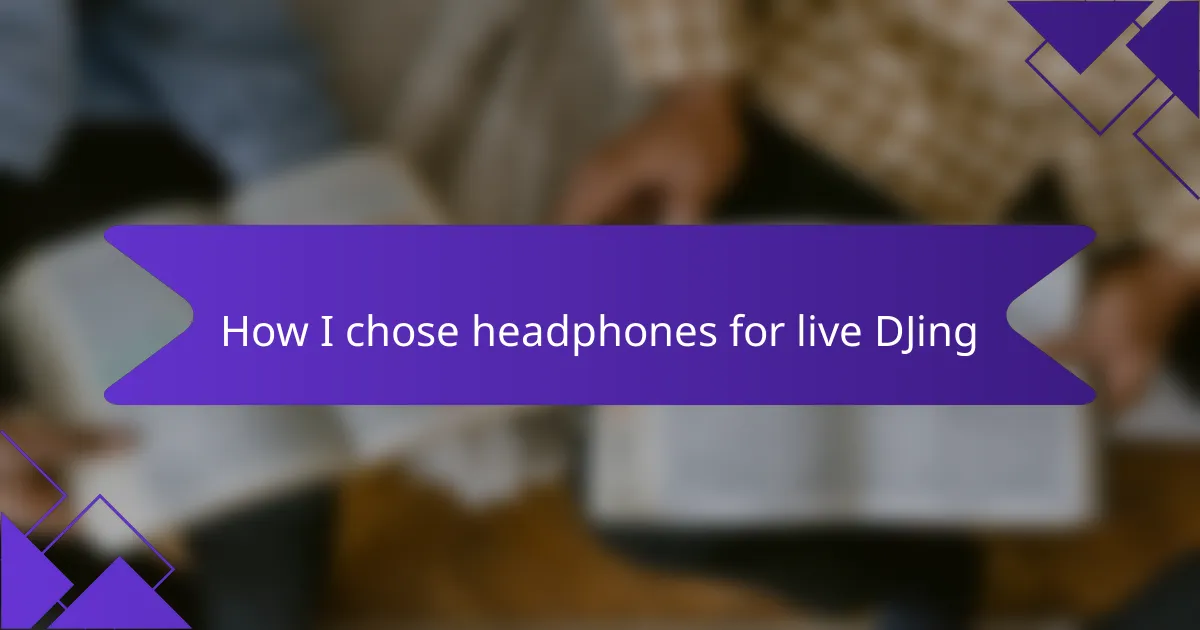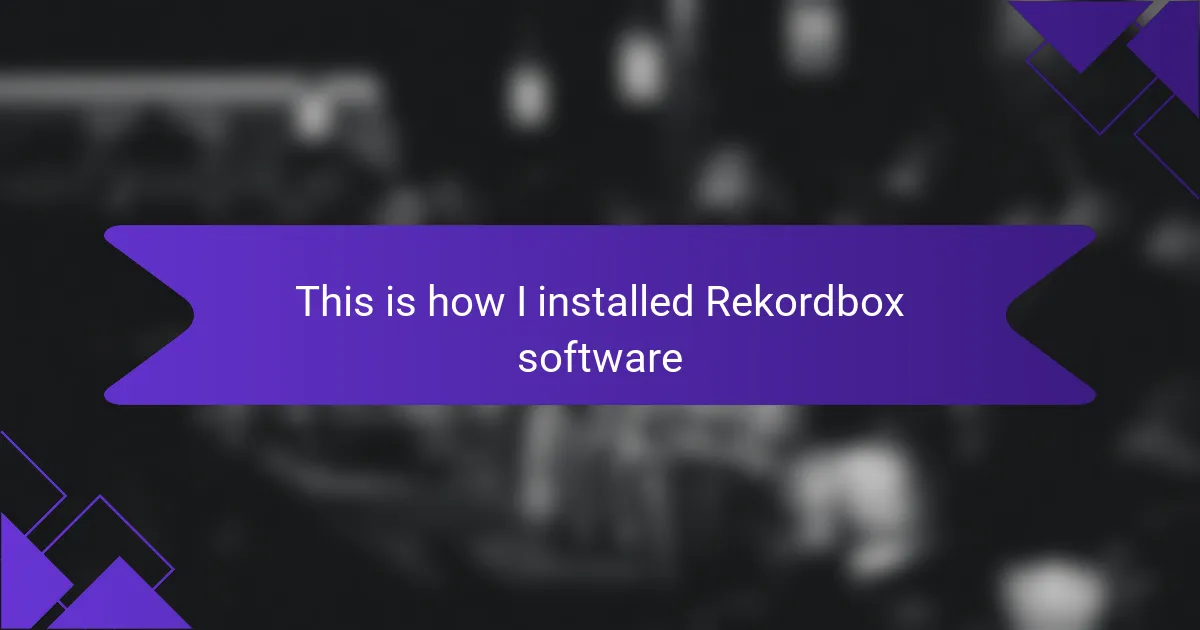Key takeaways
- A dedicated sound card significantly improves audio quality, offering clearer sound and reduced latency, which is essential for live performances.
- Multiple outputs from sound cards enhance mixing capabilities, allowing DJs to route different audio signals effectively.
- Choosing a sound card with low latency and high audio fidelity can greatly elevate DJ performances, providing a seamless connection with the audience.
- Sound cards facilitate advanced sound processing options, broadening creative possibilities and transforming set experiences for both DJs and listeners.

What is a soundcard
A sound card is a crucial component in any audio setup, especially for DJs. It serves as the interface between your computer and speakers or headphones, converting digital audio signals into sound. In my experience, using a dedicated sound card enhances the audio quality significantly compared to standard integrated options. It’s like the difference between listening to a song on a low-quality speaker and feeling the music in your bones through a high-end audio setup.
When exploring the benefits of sound cards, here’s what I find particularly noteworthy:
- Improved Audio Quality: Dedicated sound cards often deliver clearer, more detailed sound.
- Low Latency: They reduce the time it takes for your computer to process audio, which is vital for live performances.
- Multiple Outputs: Many sound cards offer multiple outputs, allowing DJs to route different audio signals for mixing.
- Enhanced Control: Sound cards typically include software for adjusting sound settings and equalization, giving you better control over your sound.
- Versatility: They can support various audio formats and are compatible with multiple devices, making them great for any DJ setup.
Having made the leap to a dedicated sound card, I can honestly say it transformed my performances. I felt a new connection to the music, and it allowed me to experiment with my mixes in ways I hadn’t imagined before.

Importance of sound quality
When it comes to DJ entertainment, sound quality is everything. I remember the first time I played an outdoor gig where the sound was muddy and indistinct. It made me realize just how much quality can affect the vibe of a party. A good soundcard can really enhance audio clarity, ensuring that every beat is crisp and every note is vibrant.
I’ve also found that high-quality sound greatly enhances the listener’s experience. When the sound is sharp, it draws people in and keeps them dancing. It makes a huge difference when your audience can feel the music, rather than just hear it. A powerful soundcard can elevate a performance from average to unforgettable.
Now, let’s compare the sound quality differences between basic audio interfaces and dedicated soundcards in a table format.
| Feature | Basic Audio Interface | Dedicated Soundcard |
|---|---|---|
| Sound Clarity | Decent | Excellent |
| Latency | Higher | Lower |
| Dynamic Range | Limited | Wide |

Overview of soundcard features
When I dive into the world of soundcards, I truly appreciate how they elevate the audio experience for DJs. Key features like high-quality audio conversion, low-latency performance, and multiple input/output options mean so much for live mixing. Personally, I’ve found that having a reliable soundcard can make or break a set; the clarity and depth of sound really impact the energy on the dance floor.
Moreover, features such as built-in effects, MIDI compatibility, and even portable designs allow DJs to customize their setup effortlessly. I remember a gig where my soundcard’s low-latency performance helped me execute a seamless transition that kept the crowd moving. It’s those moments that reinforce how essential a good soundcard is to achieving your best performance.
Here’s a quick comparison of some popular soundcard features:
| Soundcard Model | Sample Rate |
|---|---|
| Focusrite Scarlett 2i2 | 24-bit/192 kHz |
| PreSonus AudioBox USB 96 | 24-bit/96 kHz |
| M-Audio M-Track 2×2 | 24-bit/192 kHz |

Benefits for DJs
Using a dedicated sound card has been a game-changer for my DJ sets. I remember the first event where I could finally hear every subtle detail in my mixes. It was like opening a window to a whole new world of sound, where even the smallest nuances in music became alive and vibrant. Improved audio quality isn’t just about hearing the beats; it’s about feeling them resonate with the audience.
Latency is another crucial factor that cannot be overstated. I’ve experienced the frustration of trying to sync beats with a lagging audio interface. With my current sound card, however, that issue is a thing of the past. The low latency means my mixes flow seamlessly, and my transitions feel natural. It’s a thrill to see the crowd respond instantly when everything clicks perfectly into place.
Furthermore, having multiple outputs is a blessing, particularly in live scenarios. I love being able to route different audio signals, allowing me to create unique mixes on the fly. It gives a sense of control and versatility that keeps the energy alive. Every time I adjust my settings to suit the vibe of the crowd, I realize just how transformative a good sound card can be. Don’t you want that level of engagement and responsiveness in your own performances?

Personal experiences with soundcards
Using soundcards in my DJ setup has transformed my performances significantly. When I first started, I relied on built-in sound interfaces, but upgrading to a dedicated soundcard made a world of difference in audio clarity. One night, I remember the crowd’s energy skyrocketing as I smoothly blended tracks with crystal-clear sound—it was a moment of pure magic.
The difference in latency was another game changer. Initially, I would occasionally experience delays that disrupted my mix. But with a soundcard, that issue vanished. Feeling that seamless connection between my hands on the decks and the sound resonating through the speakers is indescribable.
Here’s a quick comparison to illustrate the key differences between using built-in sound interfaces versus dedicated soundcards:
| Feature | Built-in Sound Interfaces |
|---|---|
| Audio Quality | Standard |
| Latency | Higher |
| Connectivity | Limited |
| Microphone Input | Often absent |
| Dedicated Soundcards | High |
| Latency | Lower |
| Connectivity | More options |
| Microphone Input | Present |

Tips for choosing a soundcard
When choosing a sound card, one of the first considerations should be the number of inputs and outputs you need. I remember my earlier days as a DJ, where I thought one output would suffice. However, as my sets evolved, I quickly learned the importance of having multiple outputs. This flexibility allows me to simultaneously cue tracks and send different signals to my headphones, enhancing my mixing capabilities tremendously.
Another crucial aspect is the sound card’s latency performance. I can’t stress enough how much a low-latency sound card can impact your live performances. There were moments when I struggled with delays that disrupted my flow. The transition to a sound card with low latency felt like a breath of fresh air—it made everything sync perfectly, and I could connect with the crowd instantly. Have you ever felt the rush of a seamless transition? It’s exhilarating!
Finally, consider the overall audio quality when selecting a sound card. I’ve experienced soundcards that came with decent specs but failed to deliver in practice. Once, I opted for a newer model that boasted superior quality; the difference was palpable. I was able to pick up on fine details that I had previously missed, making my mixes more dynamic. It’s those nuances that can elevate a good performance into a memorable one. What is your priority—functionality or sound fidelity?

Enhancing performances with soundcards
Using soundcards can dramatically enhance performances, making every beat and melody sharper and clearer. I remember the first time I incorporated a high-quality soundcard into my setup; the difference in audio fidelity was astounding. It allowed me to focus more on my mixes without worrying about distortion or latency, which you might find frustrating during a live show.
One key advantage of soundcards is their ability to process audio more efficiently. This means you can layer sounds seamlessly, which is crucial when creating complex tracks that keep the audience engaged. Here are a few specific benefits that I’ve personally experienced:
- Improved audio quality, leading to richer soundscapes.
- Enhanced latency management, allowing for real-time mixing without delays.
- Flexibility in sound processing options, from effects to equalization.
- Increased compatibility with various software and hardware, broadening creative possibilities.
- Overall, a more professional setup that can significantly impress your audience.
As a DJ, there’s nothing quite like the rush of feeling the music resonate perfectly through a well-optimized system, and soundcards play a pivotal role in that experience.



